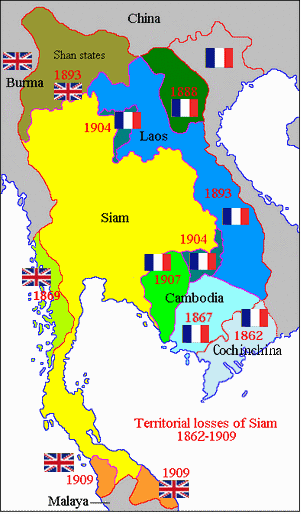- Burma and Siam fought six wars between 1785 and 1855, resulting in the exchange of two relatively minor areas (Tenasserim to Burma and Lan Na to Siam). Before that period, Burma had fought several wars with China. The Burmese kings tried to expand westward, but they clashed with the British in India. In the first Anglo-Burmese war (1824-26), the British won a decisive but expensive victory. The British took Arakan, Manipur, Assam, and Tenasserim, and and indemnity of one million pounds ($4.2 million). In the second Anglo-Burmese war (1852) the British unilaterally and easily seized the Pegu province. After the war, King Mindon tried to modernize the Burmese state and economy, and made trade and territorial concessions to stave off further British encroachments, including ceding the Karenni States in 1875. Nonetheless, the British, alarmed by the consolidation of French Indochina, annexed the remainder of the country in the third Anglo-Burmese war in 1885, and sent the last Burmese king to exile in India. The British were resented by the Burmese. Burma was governed as a part of British India, and the civil service was staffed with British and Indians, rather than Burmese. In 1937, Burma became a separate British colony, no longer part of British India. Many Burmese fought on the side of the Japanese in World War II, but many others fought on the side of the British and Americans. The country was devastated by the war. In 1948, the Union of Burma became independent, and, unlike most other former British possessions, did not become a member of the Commonwealth. In 1989, the military government changed the name of the country to Myanmar, but many opposition groups, as well as other countries, including the United States, Canada, and the United Kingdom, still use the name Burma.
- Siam was the only country in southeast Asia to escape European colonization. In 1782, a new king, Rama I, founded a new capital city, Bangkok, and drove out the Burmese. It is generally believed by the Thai people that the diplomatic skills and modernizations of King Mongkut (1804-1868) and his son King Chulalongkorn (1853-1910), enabled Siam to avoid being taken into the French or British overseas empires. This is reflected in the country’s modern name, Prathet Thai or Thailand, used since 1939 (although the name was reverted to Siam during 1945-49), in which prathet means “nation”. (However, it is also true that both the British and the French saw that leaving Siam independent provided a buffer between their two empires.) Both powers took some border areas between 1867 and 1909. During World War II, the Japanese forced Thailand, as it was called, into an alliance, demanding the right to march across the country to attack British Malaya. They also forced the French to give up some of the border areas that had been made part of Laos and Cambodia. But the Japanese did not really trust the Thai people, and many joined the resistance movement. After the war, the British, the French, and the Soviet Union wanted to treat Thailand as a defeated power, but the United States mitigated these demands. The French took back the territories they had yielded at the start of the war, and the British demanded rice to be sent to Malaya. To gain admission to the United Nations, the Soviet Union demanded the repeal of anticommunist legislation. Communist guerillas were active from the 1960s until 1987, but were never a serious threat to the state.
